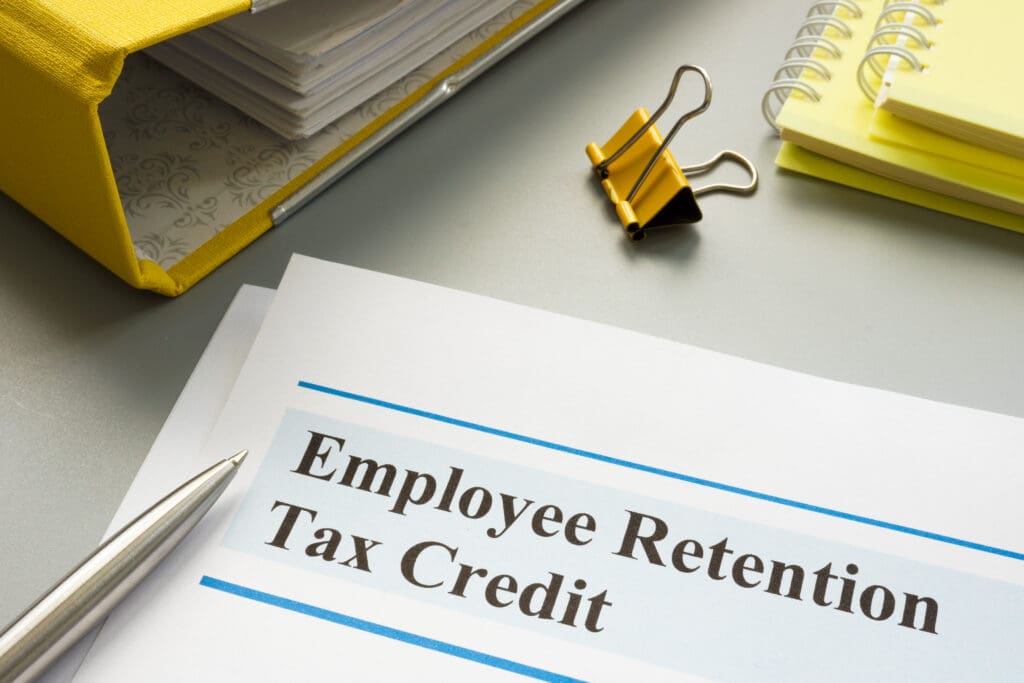The COVID-19 pandemic was hard on business operations, especially for smaller companies. More than 4,000 small businesses closed during the first three months of the pandemic, and others had to reduce their active employment by up to 50 percent.
To help businesses across the United States deal with the repercussions of the pandemic, the government enacted legislation titled the Coronavirus Aid, Relief and Economic Security (CARES) Act. As part of it, the Employee Retention Tax Credit was established. The initiative was designed to encourage eligible employers to keep their employees on the payroll during the COVID-19 outbreak.
As a refundable and non-refundable tax credit, eligible businesses can claim it on qualified wages paid to employees. This includes some health insurance costs. How you calculate your Employee Retention Credit varies based on the number of employees your business had in 2020 and 2021, and other factors, such as qualified wages paid with PPP loans or qualifying wages paid to owners and their relatives.
What Are Considered Qualified Wages for Employee Retention Credit?
Qualified wages include those paid by employers to employees while operations were fully or partially suspended by governmental COVID-19 orders. They also consist of wages paid while the business experienced a decline in gross receipts. What’s covered? Cash wages, both hourly and salaried, along with vacation pay and any other taxable wages. Qualified wages under the ERC program also include certain health plan expenses that are allocable to those wages.
Qualified wages under the ERC program are limited to the first $10,000 of compensation paid to any employee during a calendar year (2020) or calendar quarter (2021). They can be claimed for wages paid or incurred from March 13, 2020, through September 30, 2021.
Following is a year-by-year breakdown of what the Employee Retention Credit offers to eligible employers:
- 2020 ERC: A credit against certain payroll taxes of 50 percent of the qualified wages paid — up to $10k per employee — from March 12 – December 31, 2020 (capped at $5k per employee).
- 2021 ERC: A quarterly tax credit of 70 percent of the first $10,000 in qualified wages per employee in each quarter of 2021 from January to September 2021 (capped at $7K per employee per quarter).
How Do I Calculate Qualified Wages Paid for the ERC?
Calculating your ERC can be achieved by basing it on your total qualified wages paid. Again, that includes some health plan expenses. Your calculation will vary depending on how many employees your business had in 2020 and 2021. It also may be affected by wages paid with forgiven PPP loans or wages paid to owners and their relatives.
The Employee Retention Credit equals 50 percent of the qualified wages for 2020. It’s 70 percent for 2021. Note that the maximum credit amount for 2020 is $5,000 per employee for the 2020 calendar year, and for 2021 is $7,000 per employee per quarter.
The Difference in Qualified Wages for Small and Large Employers
Small businesses have an advantage when it comes to what qualifies as wages paid under the Employee Retention Credit. Small employers, which are considered those that had, on average per month, 500 or fewer full-time employees (FTEs) in 2019, are allowed the ERC on wages paid to employees. This is for wages paid January 1, 2021, through September 30, 2021 – whether or not those individuals worked — and includes qualified health plan expenses paid during an eligible quarter. For 2020, small employers were defined as companies with 100 or fewer FTEs on average per month in 2019.
Conversely, under the ERC program, large employers are considered those that averaged more than 100 full-time employees on average per month in 2019 for 2020 and those that averaged more than 500 full-time employees on average per month in 2019 for 2021. For these employers, qualified wages are typically defined as wages paid to employees who are not providing services because either the company’s operations were fully or partially suspended or there was a decline in gross receipts during qualifying quarters. Also, employers considered large under the CARES Act may qualify for non-service wages and a proportionate amount of qualified health plan costs during an eligible quarter.
Other Considerations for Qualified Wages Under the Employee Retention Credit
The ERC is similar to the Paycheck Protection Program (PPP). The PPP, however, which ended on May 31, 2021, was a forgivable loan. It provided small businesses with funds to pay up to eight weeks of payroll costs, including benefits. Funds from the PPP loan also could be used by those businesses to pay interest on mortgages, rent, and utilities.
At the start of the program, businesses that received PPP loans weren’t eligible for an Employee Retention Credit. However, through the Consolidated Appropriations Act of 2021, also known as the Relief Act, eligible businesses that received a PPP loan can now apply for the ERC — retroactively to 2020. You can’t, though, claim the ERC for qualifying employee wages paid with funds from a forgiven PPP loan.
Claiming the ERC is beneficial for most businesses, but it might also affect your 2020 and 2021 financial statements. Your ERC should be recorded as a credit to grant income and a debit to accounts receivable (A/R). If you received your Employee Retention Credit as an advance payment, you should credit the refundable advance liability and debit the cash.
Make sure you include disclosures in your financial statements about the accounting method/standard you chose — no matter which one you used. Why? It’ll help ensure your compliance with IRS rules and regulations.
The ERC has already ended. But, if you’re an eligible employer, you still have time to claim. How? By filing a Form 941-X for relevant quarters. For 2020, the deadline to apply is April 15, 2024; for 2021, the deadline is April 15, 2025. Once you’ve submitted form 941-X, you’ll need to verify that it’s been received and then you’ll be able to track the status of your ERC refund.
Conclusion
Although the Employee Retention Tax Credit is certainly beneficial for many companies, the business of claiming it properly isn’t always an easy feat. Understanding what’s considered qualified wages, which companies are eligible employers, how it’s used with the Internal Revenue Code, how it affects tax exempt organizations and recovery startup businesses, and whether it includes Medicare taxes are questions often asked.
At StenTam, we offer technology-enabled financial solutions that provide accurate, compliant, and hassle-free tax credit filings. We’re here to walk you through the whole process and ensure that your statement is accurate. Get started with us today to find out if you’re eligible for tax credits!
FAQs
Am I Considered an Eligible Employer?
Under the CARES Act of 2020, businesses eligible for ERC credits include any employer operating a trade, business, or tax-exempt organization. However, it does not apply to governments or their agencies and instrumentalities.
You are an eligible employer if your business sustained a full or partial suspension of operations limiting commerce, travel, or group meetings due to COVID-19 and orders from an appropriate governmental authority. Or if your business experienced a significant decline in gross receipts during 2020 (50 percent or more versus 2019) or the first three quarters of 2021 (20 percent or more versus 2019). If your business qualified in the third or fourth quarters of 2021 as a recovery startup business, it may also qualify for the employee tax credit.
What Documentation Do I Need for Form 941-X for My Employee Retention Credit?
Make sure you’re equipped with the following information:
- Complete payroll data
- Personal information (including Employer Identification Number)
- Prior years’ tax returns
- Copies of Form 941 filed for each qualifying quarter you plan to claim the ERC
How Do I Check the Status of My 941-X Refund?
To check on the status of your claim, call the IRS helpline at (800) 829-4933. Have your employer ID number, Social Security number, and tax return information readily available.
How Long Does It Take for IRS Form 941-X to Refund?
This varies by business, but backlogs at IRS submission processing centers have resulted in some businesses waiting six to nine months for their ERC refund check. There are more than 800 various IRS tax forms and schedules.







